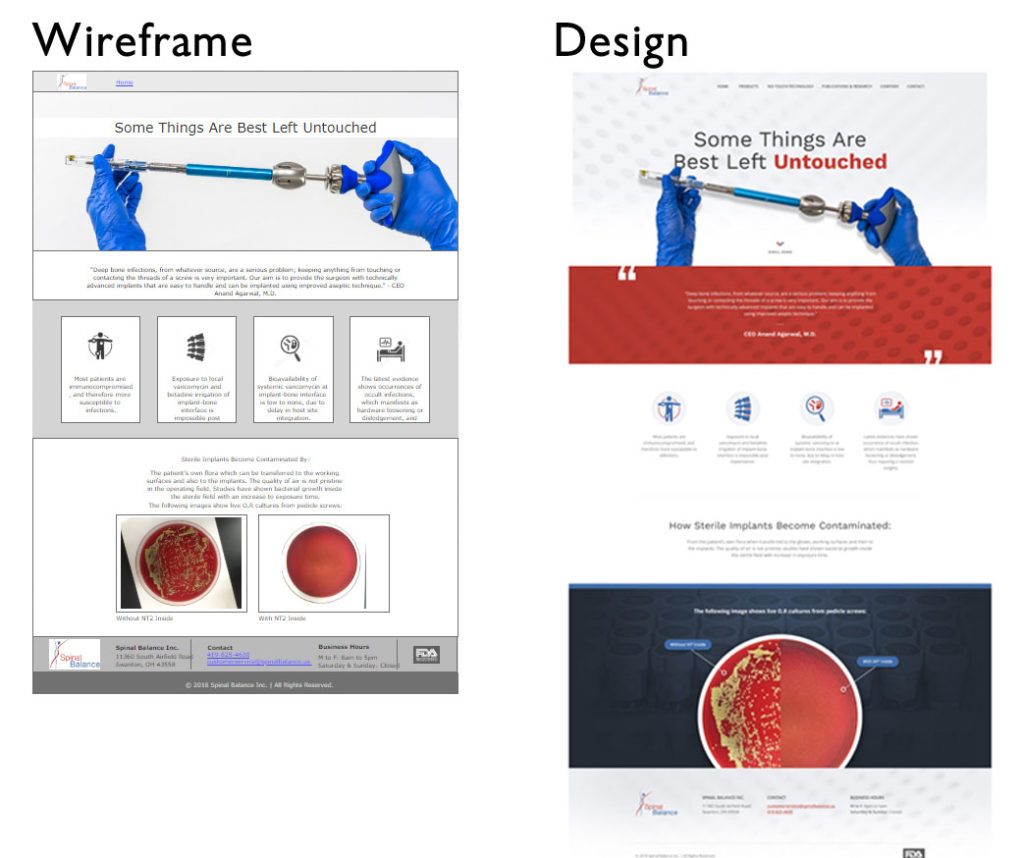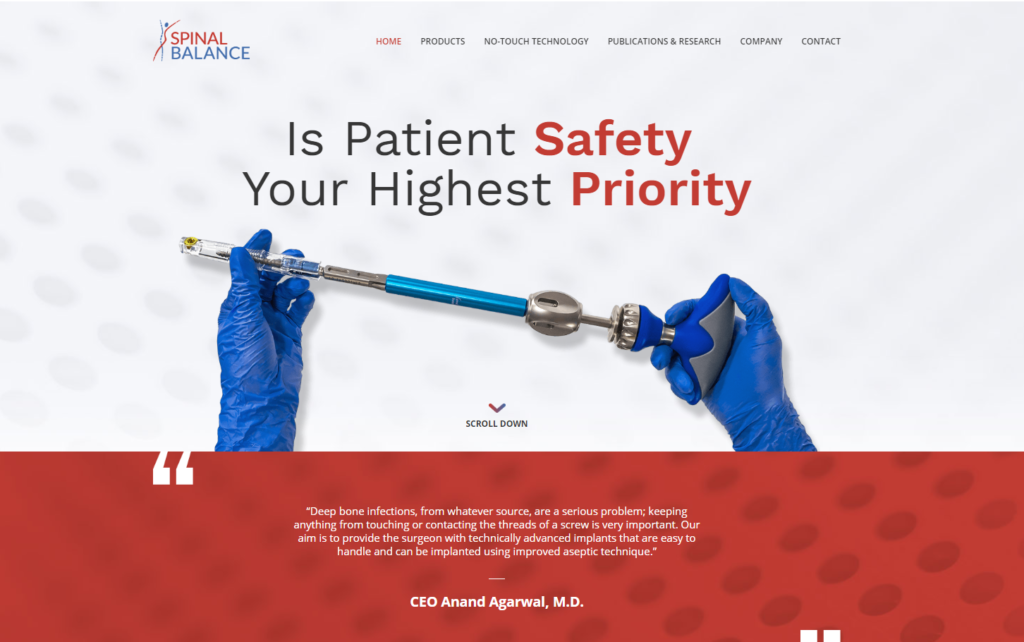Recently, we investigated healthcare website design by reviewing the websites for the top hospitals in the country. (Check out What’s Up with Healthcare Website Design in 2018 for the full story.) We found that many websites in the healthcare industry are similar to one another: many are outdated and lack innovation and diversity. However, this doesn’t have to be the case with your website.
If you need a website for a private, public, or voluntary healthcare organization, or medical equipment or pharmaceutical manufacturing company, start here. This article is written to guide you to the best medical website design possible.

The Truth
The medical industry is a magnet for designers selling template websites. “A website template (or web template) is a pre-designed webpage, or set of HTML webpages that anyone can use to “plug-in” their own text content and images into to create a website.” (source)
Be careful of designers trying to sell you a “custom” WordPress website. WordPress websites are not custom websites. (You may be interested in Why We Refuse to Build WordPress Websites.)
WordPress = Template = Not Custom
However, it is common practice for some designers (especially one- or two-person shops or those who outsource their work) to sell a template and label it as “custom.” If your website looks exactly like another website, except for your logo or brand colors, then you probably have a template website.
You Need a Custom Website
Instead of choosing a template, choose a custom website design agency. A custom design agency creates fully custom websites. That means that every piece of your website, from the content to the code to the photography, is all unique and created specifically for you.
Custom Medical Website Designs
A custom website for your medical organization or company is completely unique. Here’s how Artonic builds custom websites:
- PLAN
- WRITE
- WIREFRAME
- DESIGN
- DEVELOP & LAUNCH
- SUPPORT
- MARKET
Planning a Medical Website Design
The first stage is to PLAN your website. Why do we start with planning? We start here because it’s the most efficient and effective way to design a website. If we can iron out the strategy, details, and scope of your project, we’ll have less revisions later.
Additionally, Artonic creates user-centered websites. That means we design a website around the people who use it (a.k.a. users). Every decision we make considers the users – the people – who will use your website the most.
Usually that includes potential clients, current clients, investors, job seekers, and your marketing team. That’s a lot of people to consider!

But it’s easier than you may think. After we identify the users, we can then determine what they need (sometimes we’ll refer to this as “user needs”). For example, potential customers have different needs than job seekers.
Potential Customers’ Needs
- Services / Products Offered
- Prices
- Company Information
- Contact E-mail, Phone
This is a pretty basic list (your potential customers may need many more things from you), but it’s a good example of user needs.
Let’s compare potential customers to job seekers. Then, we’ll see how both groups differ and overlap.
Job Seekers’ Needs
- Open Positions
- Company Culture
- Contact E-mail, Phone
As you can see from the examples above, you’ll need to determine the needs for each group of users, because they are often different. There is potential for overlap as well. Here, both groups need Contact Information.
Planning your medical website design includes the creation of a sitemap. A sitemap is a hierarchy of the pages on your website. It’s very similar to the outline for a paper. Start with your Homepage, then build from there.
(For step-by-step instructions on how to create a sitemap, check out Creating a Website for Your Business.)
Writing for Your Medical Website
Once you’ve determined the pages that will be included on your website, you’ll need to create content for those pages. Content includes text, photos, videos, and audio.
With a custom web design agency, the agency will create the content for your organization. You’ll guide our researchers and writers by outlining your mission statement, capabilities, and brand message. We’ll create content written for your audience and your goals. Plus, all our content is optimized for Google. (Here’s how we Create Great Content in 5 Steps.)
Your Medical Website’s Wireframe
Once we have the content created, it’s time to build a wireframe of your website. A wireframe is a prototype or blueprint of your website. It’s completely grayscale and lacks any design elements.
You can think of it as a sketch. The wireframe lets us sketch the vision for your website in a way that you can see and interact with it.

Graphic Design for Your Website
Once your wireframe is complete, our Sr. Graphic Designer creates the custom design for your website. She uses the wireframe as a guide to design your website.
Your website design is based on your brand. Usually, that includes your logo colors and style. For example, this medical device packaging company has a red and blue logo. The website colors match the logo.
Website Development & Launch
After the custom graphic design is created for your website, it’s time to develop it. Our developers create your website code from scratch; the code is unique and secure, unlike the cookie-cutter and potentially dangerous code used for website templates.
When your website is fully coded, you can view and use it just as you will when it’s online. We put it on a development server, to allow our developers to test it prior to launch. You can access this development website and ensure the final website design works as it should.
Website Support
Maintaining your website’s performance is vital to online success. A website needs to be maintained, updated, fixed, and tested throughout its lifetime. Make sure you have a team in place to support and maintain your website.
Artonic offers full-service support to our clients. We monitor your website’s performance to ensure it’s running it’s best. We’re also available to help with minor edits or changes to your website, like text or images. (Our clients also have built-in CMSs or Content Management Systems, that allow them to make edits themselves.)
If you need website support, watch our video below. Or, please check out: Artonic’s Website Support Plan
Medical Website Marketing
Once your website is online, how will people find it?
The answer is digital marketing, advertising, and SEO. Through marketing, advertising, and SEO, your website becomes more visible online. That means more people see it. The more visible your website, the more traffic you’ll get.
Be sure to think about your website strategy, including digital marketing, before you launch your website. That way, we can implement the tools needed to achieve your marketing strategy.
Not sure what a website strategy is or how to create one? You’ll be interested in our article, Let’s Talk Website Strategy (it’s not as difficult as you think).
Your Custom Medical Website Design
If you’re creating a website, it’s important to get all the details right. Need help? That’s why Artonic is here – to support your goals and make your website a success.
Each medical website we build is completely custom. We do not use templates. (Find out why a custom website design matters). Every piece of your website is created specifically for YOU – your goals, your audience, your strategy, and your brand.
Find out what it’s like to work with an agency to create the website of your dreams: View videos and read case studies about stories from our clients.
Say Hello!
Give Artonic a call or email us if you’re interested in website design, development, or marketing.
Michigan, USA


